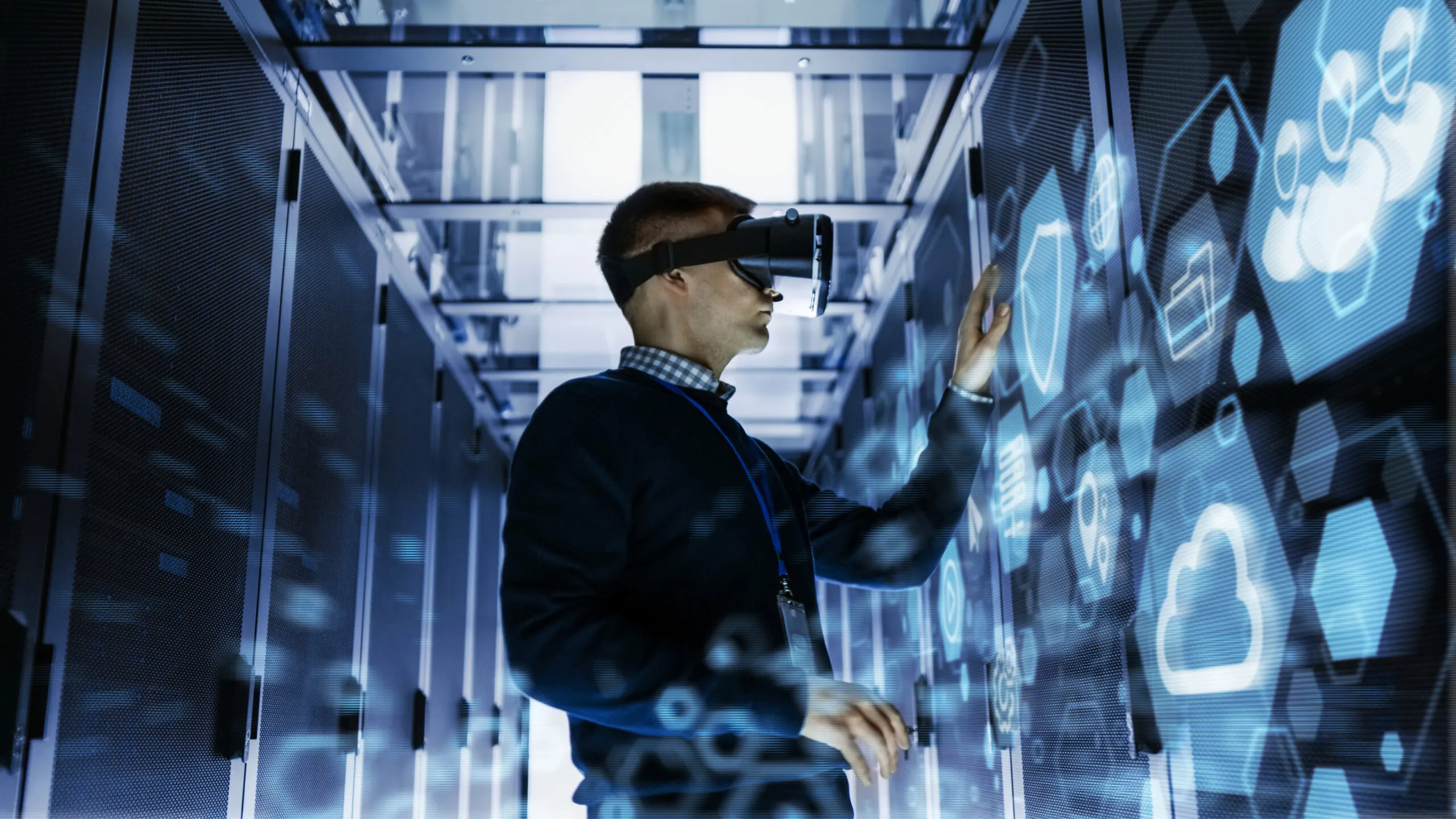How Augmented Reality Tools Can Help with Data Center Design and Reconfiguration18 min read

Oculus virtual reality (VR) headsets burst onto the scene a few years ago for immersive gaming and entertainment experiences. Novel as they are, a far more practical use case is emerging. Many augmented reality (AR) tools are being harnessed in the design of data centers, in envisioning how equipment will look and function in the real-world environment, in monitoring operations, and in the care and maintenance of equipment.
Here are a few of the primary use cases for AR in the data center.
AR Glasses for Maintenance
AR glasses are gradually entering into all kinds of maintenance activities. The person wearing them can walk around the data center and the glasses will show in real time the piece of equipment being looked at as well as its specifications, any outstanding work orders, relevant metrics and more.
Various data center software providers, for example, augment AR headsets and glasses with their own software to display such things as rack content without opening rack doors, tracks the connections between resources or ports and help inexperienced technicians find the position of components and equipment.
AR for Remote Operation and to Address Staffing Shortages
Those managing multiple facilities or running data centers for others have gotten used to dispatching a technician to the site. AR adds a new dimension by reducing the need to dispatch a technician.
This is particularly relevant in an age when many veteran IT personnel are graying out. When they retire, they rarely leave behind competent replacements. Too many data centers have seen a valued employee leave without someone else being hired due to corporate mandates to keep headcounts low. Such tools also play a role in addressing the shortage of skilled technicians and data center experts.
AR in Training and Apprenticing
AR is useful as a training aide. AR-enabled simulations can provide a realistic and immersive training experience, allowing technicians to practice and improve their skills without the risk of causing damage to the data center. Once trained, new techies in data centers can be guided step-by-step through complex maintenance procedures until they themselves possess the know-how to do it unassisted.
One experienced person can run other less experienced or even novice technicians remotely. The manager can sit in the office and see what the others are looking at on the screen. He or she can pass instructions onto the others through their headsets and send them lists of things to do or check to address issues.
AR in Data Center Construction
There are also headsets that combine hard hats with AR glasses. Those involved in data center construction can see displays of virtual buildings and view 3D design models on-site. Such software can also incorporate health & safety risk assessments to help users avoid potential hazards.
For AR to be indispensable to those within the construction industry, it must directly enhance the users’ ability to deliver efficiency and productivity gains and, of course, increase quality in real-time. With a good portion of the work performed by construction companies being rework, AR tools like this can boost productivity and prevent data center projects falling behind.
AR in Equipment Selection
Equipment selection is another area where AR is gaining ground to support data center operators and IT managers in immersive product exploration. This helps users when they are making purchasing decisions by guiding them through product selection and placement. AR can deliver a realistic depiction of equipment in desired locations within the data center or server room. Such applications superimpose photo-realistic 3D models over the physical environment of its users’ choosing, be that a conference room, an open site, or the data center they want to place it in. Thus, users can visualize how new products will interact with their existing environments and explore details about those products.
Augmented and Virtual Reality in Action
EkkoSense, for example, offers virtual reality and digital twin technology as part of its EkkoSoft Critical software. This is used to define sustainable optimization strategies for data center infrastructure. Its immersive AI-driven self-optimization tools gather machine learning data at a granular level. This enables data centers to create a virtual copy of data center equipment and operations – a digital twin. Data center managers can then view cooling, power and space data at an individual rack level using IoT-enabled wireless sensors, interpret complex data and highlight anomalies. Millions of data points can be translated into insights to support real time optimization decisions. This can provide operations teams with clear recommended and auditable actions.
Three UK, for example, is a British connectivity company that has 9.9 million customers, a network that covers 99% of the UK population and handles some 28% of the UK’s mobile data traffic. The company wanted to reduce energy consumption by 5% at its aging data center facilities due to soaring energy costs and a desire to forward its own green initiatives. Cooling efficiency was identified as one of the most effective ways to help optimize its data center energy performance and secure environmental improvements.
EkkoSense’s EkkoSoft Critical 3D monitoring, visualization and analytics platform was implemented to achieve these objectives. Before beginning the optimization phase, the EkkoSense team conducted a comprehensive physical survey across our four legacy sites. They deployed Internet of Things-enabled sensors to provide insights to take the project forward.
According to Three’s Data Centre Operations and Service Readiness Manager, Shamim Mohamed, EkkoSoft provided cooling energy savings across four sites of 200 kW, representing a 12.5% data center cooling energy saving in under ten weeks. In addition, operating costs were reduced of around $300,000 per year.
Real-time monitoring, data-driven optimization.
Immersive software, innovative sensors and expert thermal services to monitor,
manage, and maximize the power and cooling infrastructure for critical
data center environments.
Real-time monitoring, data-driven optimization.
Immersive software, innovative sensors and expert thermal services to monitor, manage, and maximize the power and cooling infrastructure for critical data center environments.

Drew Robb
Writing and Editing Consultant and Contractor
0 Comments